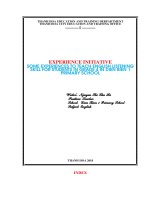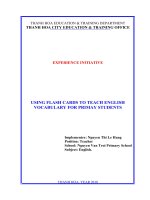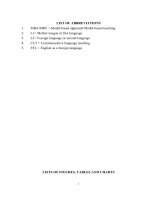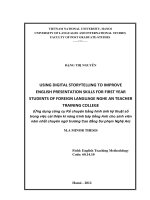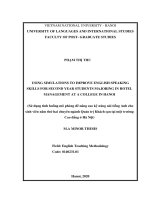Using interactive approach to teach english listening skills for lower secondary school students
Bạn đang xem bản rút gọn của tài liệu. Xem và tải ngay bản đầy đủ của tài liệu tại đây (1.63 MB, 109 trang )
THAI NGUYEN UNIVERSITY
SCHOOL OF FOREIGN LANGUAGES
PHAM THI MY HANH
USING INTERACTIVE APPROACH TO
TEACH ENGLISH LISTENING SKILLS FOR
LOWER SECONDARY SCHOOL STUDENTS
M.A THESIS
Field: English Linguistics
Code: 8220201
THAI NGUYEN – 2022
THAI NGUYEN UNIVERSITY
SCHOOL OF FOREIGN LANGUAGES
PHAM THI MY HANH
USING INTERACTIVE APPROACH TO
TEACH ENGLISH LISTENING SKILLS FOR
LOWER SECONDARY SCHOOL STUDENTS
M.A THESIS
(APPLICATION ORIENTATION)
Field: English Linguistics
Code: 8220201
Supervisor: Nguyen Thi Que, Ph.D
THAI NGUYEN – 2022
ĐẠI HỌC THÁI NGUYÊN
TRƯỜNG NGOẠI NGỮ
PHẠM THỊ MỸ HẠNH
SỬ DỤNG PHƯƠNG PHÁP TƯƠNG TÁC ĐỂ DẠY
KỸ NĂNG NGHE TIẾNG ANH CHO HỌC SINH
TRUNG HỌC CƠ SỞ
LUẬN VĂN THẠC SĨ
(Định hướng ứng dụng)
Ngành: Ngôn ngữ Anh
Mã số: 8220201
Cán bộ hướng dẫn: TS. Nguyễn Thị Quế
THÁI NGUYÊN – 2022
DECLARATION
I hereby certify that the minor thesis entitled: “Using interactive approach to teach
English listening skills for lower secondary school students”, which is submitted in
partial fulfillment of the requirements for the degree of Master of Languages at
Department of English Linguistics of Post-Graduate Studies, School of foreign
languages, Thai Nguyen University, is the result of my own work. I have provided
fully documented references to the work of others. The material in this thesis has not
been submitted to any other university or institution wholly and partially.
Approved by Author’s signature
SUPERVISOR
Nguyen Thi Que, PhD Pham Thi My Hanh
Thai Nguyen – 2022
i
ACKNOWLEDGTMENTS
This research paper would not have been completed without the help of people to
whom I would like to express my deep gratitude.
First and foremost, I would like to express my deepest gratitude to Mrs. Nguyen
Thi Que, my supervisor, for her wholehearted support, continuous motivation and
precious guidance which were decisive factors to the completion of the thesis.
Secondly, I would like to thank all the teachers of the master's course at the
foreign language school who helped me during my master's degree.
Thirdly, I would like to extend my special thanks to all the research participants,
especially my students. Without their valuable opinions and ideas in the
questionnaires, the study would not have been accomplished.
Last but not least, I owe my family their continuous support. Their patience and
love have helped me go beyond what sometimes looks like an insurmountable task.
ii
ABSTRACT
This study aims at investigating the impact of using interactive approach to
teaching English listening skills for lower secondary school students at Thinh Duc
Lower Secondary School, Thai Nguyen province. Specifically, the researcher tried to
a investigate: (1) the difficulties that secondary school students were facing when
learning listening skills and the effects of applying the interactive process in teaching
English listening skills to secondary school students, and (2) the students’ attitudes
towards using interactive approach in teaching English listening skills. To achieve the
above-mentioned objectives, an action research was conducted with the participation
of 45 grade 7th students at Thinh Duc Secondary School, Thai Nguyen province. A
pre-test, a post-test and two sets of questionnaires were used as instruments to collect
data for analysis. The findings show that there were several factors that caused
difficulties to students in English listening competence such as new vocabulary and
structures, background knowledge of the topics, unfamiliar topics, the inability to
catch up what speakers said, the speed of the talk, students' limited ability of
pronunciation as well as listening to stress and intonation etc. In addition, results of
pre-test and post-test revealed a significant difference in students’ listening
comprehension performance. More specifically, the findings proved that interactive
approach had a positive effect and enhanced students’ listening skills substantially.
iii
TABLE OF CONTENTS
DECLARATION ..................................................................................................... I
ACKNOWLEDGTMENTS.................................................................................. II
ABSTRACT .......................................................................................................... III
TABLE OF CONTENTS..................................................................................... IV
LIST OF TABLES ..............................................................................................VII
LIST OF FIGURES .......................................................................................... VIII
LIST OF ABBREVIATIONS.............................................................................. IX
CHAPTER 1: INTRODUCTION..........................................................................1
1.1. Rationale..........................................................................................................1
1.2. Research aims..................................................................................................3
1.3. Research questions ..........................................................................................3
1.4. Scope of the study ...........................................................................................3
1.5. The significance of the study...........................................................................4
1.6. Methodology of the study................................................................................4
1.7. Design of the thesis .........................................................................................4
CHAPTER 2: LITERATURE REVIEW..............................................................6
2.1. Listening ..........................................................................................................6
2.1.1. The Definition of Listening.........................................................................6
2.1.2. Types of listening........................................................................................7
2.1.3. Listening processes .....................................................................................9
2.1.4. Factors affecting listening processes.........................................................16
2.2 Interactive teaching ........................................................................................18
2.2.1 The Definition of Interactive teaching .......................................................18
2.2.2 Features of interactive teaching .................................................................18
2.2.3 Interactive teaching environment...............................................................19
2.3 Teaching listening skills.................................................................................20
23.1 Stages of a listening lesson .........................................................................20
iv
2.3.2. Interactive process in teaching listening skills..........................................22
2.4. Review of Previous Studies Related to the Research Area of the Thesis .....27
2.5. Summary .......................................................................................................28
CHAPTER 3: RESEARCH METHODOLOGY ...............................................29
3.1. Rationale of the use of action research..........................................................29
3.2. Research setting.............................................................................................30
3.3. Selection of participants ................................................................................31
3.4. Data Collection Instruments..........................................................................31
3.4.1 Pre-test and Post-test ..................................................................................31
3.4.2 Questionnaires............................................................................................31
3.5. Research design .............................................................................................32
3.6. Data collection procedures ............................................................................33
3.7. Evaluating the plan ........................................................................................36
3.8. Summary .......................................................................................................36
CHAPTER 4: FINDINGS AND DISCUSSIONS ...............................................37
4.1. Results of the preliminary investigation questionnaire .................................37
4.1.1. Students’ perceptions in listening skills....................................................37
4.1.2. Factors affecting students’ listening performance. ...................................38
4.1.3 Reasons for students’ poor performance in English listening skills ..........38
4.2. The effect of interactive approach on students’ listening skill. ....................40
4.2.1 Results from the listening Pre-test and Post-test:.......................................40
4.2.2. Results from questionnaire after the intervention of interactive approach44
CHAPTER 5: CONCLUSIONS AND RECOMMENDATIONS.....................49
5.1. Summary of findings and conclusions ..........................................................49
5.2. Limitations.....................................................................................................50
5.3. Recommendations .........................................................................................50
5.4. Reflections.....................................................................................................51
REFERENCES ......................................................................................................52
v
APPENDIX 1: SAMPLE INTERACTIONS USED IN LESSONS .................... I
APPENDIX 2.1 ............................................................................................... XXIX
APPENDIX 2.2 ..............................................................................................XXXII
APPENDIX 3 ................................................................................................. XXXV
APPENDIX 4 ............................................................................................... XXXIX
APPENDIX 5 .................................................................................................... XLII
vi
LIST OF TABLES
Table 1.1: Some kinds of bottom-up exercises for beginners ...................................25
Table 1.2: Some kinds of top-down exercises for beginners ....................................26
Table 2.1. Action plan for the research .....................................................................34
Table 3.1. Listening results in previous semester .....................................................37
Table 3.2. Students’ opinions about listening skills.................................................37
Table 3.3. Factors affecting students’ performance in listening skills......................38
Table 3.4: Reasons for not catching up with listening ..............................................38
Table 3.5. Perception on students’ vocabulary level.................................................39
Table 3.6. Perception on students’ pronunciation .....................................................39
Table 3.7. Perception on connected speech (linking, elision) used in listening text 40
Table 3.8. Perception on structures used in spoken language...................................40
Table 3.9. Comparison of Students’ Performance in the Pre-test and Post-test .......41
Table 3.10. Paired Samples for Means......................................................................42
Table 3.11. Paired Samples Test ...............................................................................43
Table 3.12: Students’ Evaluation of the Learning Sessions using interactive approach. .... 45
vii
LIST OF FIGURES
Figure 3.1. Action Research Model 1 ..................................................................30
Figure 3.5. Action research model 2 ....................................................................32
Figure 4.1. Descriptive statistics of Pre-test and Post-test ...................................41
Figure 4.2. Students’ Satisfaction with the Course ..............................................44
Figure 4.3. Students’ level of interest after the intervention................................47
viii
LIST OF ABBREVIATIONS
CLT Communicative language teaching
ESL English as a Second Language
EFL English as a Foreign Language
ix
CHAPTER 1: INTRODUCTION
1.1. Rationale
Nowadays, in the booming era of science, technology, and information, it is very
necessary for citizens in each country to grasp the most commonly used language,
that is English, as a means of communication and integration with other countries in
the world. Therefore, English has undoubtedly become the number one foreign
language taught in Vietnam.
In the past, the main goal of teaching and learning foreign languages was reading
comprehension to serve literary, scientific, and technical research. Today, in order to
serve the open policy of innovation and globalization with the region and the world,
the goal of foreign language teaching is communication. Therefore, for students to
communicate well, it is essential for teachers to shift their traditional grammar-
translation teaching methods to communicative methods focusing on listening and
speaking skills.
Listening is one of the four important skills of learning a foreign language since
we cannot communicate without it. In order to have a successful conversation, we
have to pay attention to understanding what other people say so that we can respond
to it. However, the teaching of listening skills is sometimes overlooked in many
educational institutions due to several reasons such as lack of facilities for teaching
listening, poor-quality listening resources, and no compulsory requirement of
listening skills in mid-term or final tests.
In fact, many students claim that listening is the weakest and most difficult of
the four skills. Why is listening so difficult? It is because of the fact that when students
listen to the teacher, they get used to the teacher's tone. In addition, teachers can read
slowly, use gestures or actions to illustrate difficult listening parts. Hence listening
becomes easier. But when listening to the tapes or recordings, students face the
difficulties of being unable to control of what they hear, the speech on the tape is too
fast, the content contains many new words etc. Students who do not listen regularly
will not recognize words that they know. So how to help children expand their
listening range so that a lesson in listening is less stressful and enjoyable. This is the
1
big question that makes English teachers think. Steven Brown state:
“Listening in another language is a hard job, but we can make it easier by
applying what we know about activating prior knowledge, helping students organize
their learning by thinking about their purposes for listening, and if speaking is also a
goal of the classroom, using well-structured speaking tasks informed by research.
Another theme will be motivation. Because listening is so challenging, teachers need
to think carefully about making our activities successful and our content interesting”.
Steven Brown (2006)
Thinh Duc Lower Secondary School is a public school in the suburb of Thai
Nguyen City. The school has three grade 7 with about 40 to 45 mixed-level students
in each class. Through classroom observations and interviews with students during
the process of teaching, the research has found that most of the students were exposed
to English quite late, and their English ability was rather limited. Furthermore, many
of them did not have the habit of learning English independently and usually depended
on textbooks and teachers to acquire knowledge. Most children learned English
because it was a compulsory subject, and they learnt it just to pass written tests. Some
of the students did not have a desire to communicate with other people in English both
inside and outside the classrooms. Most students found it difficult to express their
ideas in speech and writing and did not understand key information from conversation
or text in audio and texts. Their listening skills were under acceptable levels because
most of the students were passive listeners. They only listened when studying English
lessons or taking tests, so the authentic environment to develop and enhance listening
skills for students was almost nonexistent. As an English teacher having taught for
lower secondary school students for several years, I have found that students here
were having many difficulties with learning listening or were even afraid of listening
lessons. They would prefer not to play out any listening errands and perform
ineffectively in listening tests. The question here is to find the right approach to help
students develop their listening skills.
Through browsing many studies on methods to teach listening, the author has
found that interactive approach has proven to be very effective in teaching listening
2
to EFL students in many different contexts and may be the answer to solve problems
for secondary students at her own teaching context. Therefore, all the above reasons
have urged the researcher to carry out the study entitled: “Using interactive approach
to teach English listening skills for lower secondary school students”.
1.2. Research aims
This study is intended with the aim of researching whether interactive approach
helps students improve their listening skills in English. To attain this aim, the
subsequent objectives are commenced for the study:
- To realize an understanding of the difficulties encountered by grade 7 students
at Thinh Duc lower secondary schools and the effects of applying the interactive
process in teaching English listening skills. (2) the students’ attitudes towards using
interactive approach in teaching English listening skills.
- To investigate the students’ attitudes towards using an interactive approach in
teaching English listening skills.
1.3. Research questions
The aim of this study focuses on investigating the effects of the interactive approach
in teaching listening skills and identifying students’ attitudes towards the use of the
interactive approach at Thinh Duc Lower Secondary School, Thai Nguyen province.
Therefore, the specific research questions addressed in this study are as follows:
1. To what extent does the use of interactive approach enhance students’
listening skill?
2. What are the students’ opinions towards the use of interactive approach in
teaching listening skill?
1.4. Scope of the study
In this study, the researcher did not have the ambition to study all strategies to
enhance listening in children. There are many strategies to teach and improve
listening ability, however, in this study, the researcher used an interactive method to
help students at Thinh Duc Secondary School overcome difficulties in and enhance
listening skills. The researcher was assigned to teach English to 13 years old students
at Thinh Duc Secondary School, Thai Nguyen City. However, due to the time
3
constraint, the researcher only focused on using experiencing interactive approach to
teaching listening skills to 45 secondary students of grade 7A during the study period
of 8 weeks and then asked students to respond to a questionnaire about their opinions
and attitudes towards the use of interactive approach after trial teaching.
1.5. The significance of the study
The study is supposed to add to the advancement of educating and mastering
listening abilities. It targets assisting understudies with further developing their
listening abilities by utilizing interactive approach. By drawing out the aftereffects of
the impact of interactive approach to foster understudies' listening abilities, and
furnishing educational ramifications in managing this methodology, the research will
some way or another make the accompanying commitments. To start with, the
discoveries of the study might be filled in as references for the educators of English
to intend their instruction for a more successful methodology. Moreover, the
popularization of the findings would presumably facilitate the scientist herself and her
colleagues to improve their teaching skills. It also aids in the development of a
welcoming learning environment. In addition, it allows students to use and learn the
language in practical and substantive ways. Lastly, it also aims at increasing the
volume of research in learning English listening for Vietnamese learners, especially
for secondary students in Thai Nguyen.
1.6. Methodology of the study
Conducting the study, the researcher follows the general steps in Nunan's action
research model (1992). She makes use of the quantitative method with the wish to
explore the matter thoroughly. The data are collected from the two following sources:
- Pre-test and post-test
- Two survey questionnaires
Pre-test and post-test are used to assess the quality of the participants' listening
performance before and after the research. The two questionnaires are carried out
after the pre-test and post-test, and their aim is to confirm and supplement the results
of the tests.
1.7. Design of the thesis
This thesis consists of five chapters:
Chapter 1: Introduction presents the rationale for conducting the study a longing with
4
its aims, research questions, methods, significance and design.
Chapter 2 - Literature Review conceptualizes the framework of the study including
the key concepts. A brief overview of the related studies are also provided.
Chapter 3 - Research methodology presents the context, the methodology used in
this study including the objects, data collection instruments, data collection
procedure and analysis.
Chapter 4 – Findings presents, gives a comprehensive analysis of the data and
discussion gives on the findings of this study.
Chapter 5: Conclusion offers the summary of findings, implications, limitations,
recommendations and reflection of the researcher.
5
CHAPTER 2: LITERATURE REVIEW
This chapter conceptualizes the framework of the study including key concepts
of listening, motivation and the application of using interactive approach to teaching
listening skills for lower secondary school students.
2.1. Listening
2.1.1. The Definition of Listening
In terms of listening definitions, Anderson and Lynch (1988) had two influential
views: traditional view and alternative view.
As indicated by the traditional view, listening is viewed as one of the responsive
abilities. Students simply tune in to the messages or accounts and attempt to
comprehend the significance of the speaker's expressions without seeing such factors
as demeanor and shades of importance. This prompts an issue that instructors simply
test understudies' limit of hearing, not understudies' comprehension of the discussion
or talk. In this conventional manner, it is believed that encouraging listening is for
sounds, however not for significance. Subsequently, this view is condemned as
unseemly and insufficient by Anderson and Lynch (1988).
Nonetheless, students are viewed as dynamic model developers in the elective
view. New data and audience members' own experience information are joined to
arrive at full cognizance of what has been heard. Anderson and Lynch (1988) concur
with this view, which accentuates the dynamic translation and mix of audience
members on approaching data. Littlewood (1981) upholds this view also. The creator
comments that listening requires dynamic inclusion from audience members. The idea
of listening perception is that the audience members ought to be urged to be occupied
with a functioning interaction of tuning in for importance, utilizing etymological signs
and non-phonetic information.
Listening is a receptive skill that involves responding to the oral language rather
than producing the written language. It is very useful in habitual action. Helgesen
and Brown (2007:3) say, “Listening competence is larger than speaking competence”.
There are many definitions of listening as Helgesen and Brown (2007; 4) cited: 1.
“Listening is the process of constructing meaning from spoken input. It means
6
listening is not only hearing what people say but also comprehends it” (Rost, 2007:3).
9 2. “Listening comprehension is the process of understanding speech in a first or
second language. The study of listening comprehension in second language learning
focuses on the role of individual linguistic units (e.g. phonemes, words, grammatical
structures) as well as the role of the listener's‟ expectations, the situation and context,
background knowledge and topic” (Richards and Schmidt, 2002:313).
Listening is seen as a functioning cycle in which people center around chosen
parts of aural info, build significance from entries, and afterward relate what they have
heard to existing information (Bentley & Bacon, 1996). All in all, listening is a
functioning interaction of building significance and this is finished by applying
audience members information to the approaching sounds in which various sorts of
information are included including etymological information and non-phonetic
information (Buck, 2001) because "comprehension takes place when input and
knowledge are matched against each other" (Faerch & Kasper, 1986, p. 264).
In short, in order to be successful in listening, it is advisable that "listening
comprehension is not a skill which can be mastered once and for all then ignored
while other skills are developed. There must be regular practice with increasingly
difficult materials" (Wilga, 1986, p. 157).
2.1.2. Types of listening
There are many varieties of listening. we are able to classify these in keeping
with variety of variables, together with listening purposes, the role of the beholder
and therefore the sorts of text being listened to:
2.1.2.1 Real-life listening
Several students see an enormous gap between listening activities within the
schoolroom and actual situations. this is often as a result of most listening materials
including dialogues in textbooks are terribly grammar-oriented and controlled in
many ways. The speakers often speak with utterly controlled speech, voice, tone,
accent and proper grammar. In real-life conversations, learners encounter numerous
individuals of various genders, ages, accents, speeds, voices, and tones. There could
also be improper usage, incomplete sentences, redundancy, contractions, overlap,
7
etc. There are 2 ways in which within which individuals typically listen in real-life,
they're casual and focus listening.
a) Casual listening
A lot of students have a habit of listening to a radio while studying or the
television is on while they are doing something else. They listen with no particular
purpose. This kind of listening is called casual listening.
b) Focus listening
Focus listening happens when listening for a particular purpose to get the
information we need to know or to study the language. In this case, listeners often
listen with much attention, but they do not listen to everything with equal
concentration. There is an association between listener's expectation and purpose and
his comprehension. If the listener's expectations and needs are intentional, his
listening is likely accurately perceived and understood than which is not relevant or
helpful.
2.1.2.2 Classroom listening
Classroom listening may be divided into two types: intensive listening and
extensive listening.
a) Intensive listening:
Intensive listening is the careful, focused listening to a short passage for detailed
information or full comprehension; For example, listening to a dialogue on the tape
to study its structures, intonation patterns in an English class.
b) Extensive listening:
Extensive listening is freer and more general listening to natural language or
general ideas, not for particular detail or not necessary under the teacher's guidance.
The listening passage for extensive listening can be long or short. The language that
is used in the type of listening is often within the students' ability so that they find
it pleasing and interesting when they are listening. With this type of listening,
students are not reinforcing a structure or practicing a grammar point linked to the
rest of the course.
8




